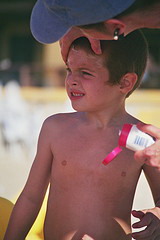 These days there is an overabundance of sunscreens on the market: Creams, sprays with or without retinol, with SPF30, 50, 100! How do you choose one that is safe and effective for you and your loved ones? Here are a few tips to keep in mind.
These days there is an overabundance of sunscreens on the market: Creams, sprays with or without retinol, with SPF30, 50, 100! How do you choose one that is safe and effective for you and your loved ones? Here are a few tips to keep in mind.A good sunscreen should block out both UVA and UVB light, in other words it should be labeled as broad-spectrum. Most sunscreens do a good job of blocking UVB, but aren’t so great when it comes to UVA.
The main ingredients in your sunscreen should be zinc oxide or titanium dioxide. Both of these products sit on top of the skin to create a temporary barrier that essentially blocks out the harmful ultra violet (UV) rays from the sun, both UVA and UVB. This is especially important for children because it means that chemicals are not absorbed into the skin.
Most sunscreens contain a long list of chemicals, often with long unpronounceable names, whose safety has not been clearly established. Many of these chemicals are suspected endocrine disruptors, meaning they can interfere with hormonal functions. One popular chemical found in sunscreens is oxybenzone. It is absorbed by the skin and easily enters the bloodstream. Avoid products with oxybenzone as there is evidence that it has estrogenic properties that likely affect reproductive functions.
There is another group of chemicals that are also used in sunscreens to absorb UV rays, specifically UVA, and appear to be safe. My first choice for kids is titanium dioxide and zinc oxide, so I wouldn’t suggest using these other ones on the little ones. (Just remember infants under the age of 6 months should avoid direct sunlight and should not use sunscreens.)
I think these other compounds are a good option for those who don’t like the white layer left behind with zinc and titanium based formulations. Avobenzone or Mexoryl SX are two chemicals that absorb UV light, rather than reflect it. In combination they offer excellent UVA protection. Tinosorb S and M are similar in that they absorb UV rays and also offer good protection from UVA. They also appear to be safe.
Another product to avoid in sunscreen is Vitamin A, written on the label as retinyl palmitate or retinol. It is added to sunscreens because Vitamin A is an anti-oxidant and prevents against free radical damage. However, it has been observed that in sunscreens it has the opposite effect. When exposed to UV light it can actually increase the risk of cancer by speeding up tumor formation. Here is an interesting study related to this subject.
The best SPF (sun protection factor) is any number between15 to 50. The SPF is an indication of UVB protection. There is no evidence that higher values are actually more effective. They offer a false sense of protection and people often stay in the sun longer than they should. After time and with exposure to the sun, the chemicals in the sunscreen begin to breakdown and are not as effective. Sunscreen should be reapplied approximately every 2 hours and after swimming, sweating profusely, or if the product rubs off.
Finally avoid aerosols and sprays because the chemicals become airborne and can easily be inhaled. The chemicals can then easily enter the bloodstream. Cream and lotions are best. Don’t forget to apply generously!
The Environmental Working Group’s website offers excellent information regarding sunscreens. Click here to see how they rate sunscreens, and which receive the best reviews. Click here to see which products should be avoided and why.
Dr. Melissa Rodriguez is a Naturopathic doctor who lives with her family in Beijing, www.drmelissarodriguez.com



